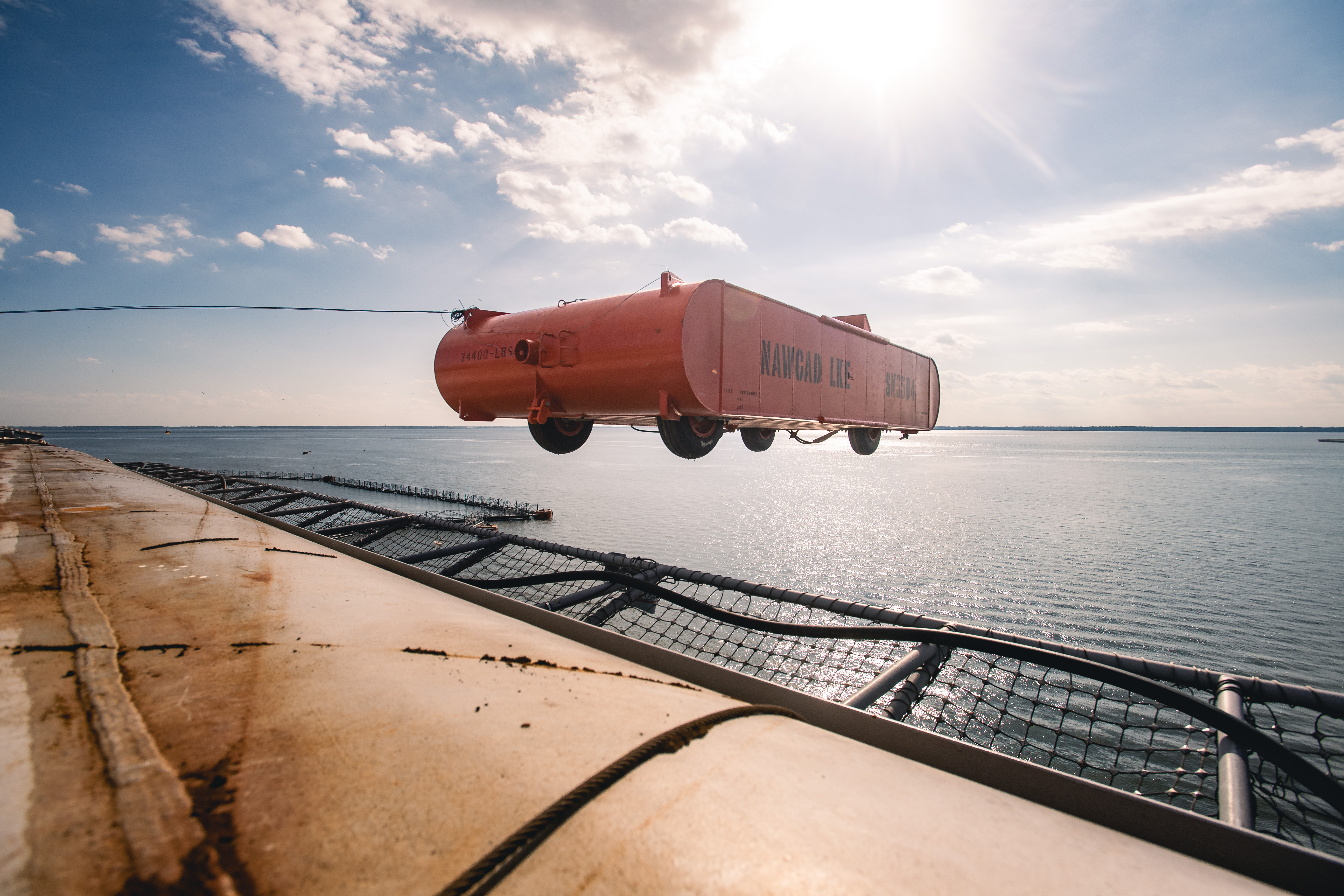HII Begins Topside EMALS Testing on John F. Kennedy (CVN 79) at Newport News Shipbuilding
- None.
- None.
Insights
The commencement of topside testing of the EMALS on the John F. Kennedy (CVN 79) signifies a critical juncture in naval defense capabilities and the ongoing modernization of the U.S. Navy's fleet. The successful integration of EMALS technology on the USS Gerald R. Ford and its subsequent deployment on the John F. Kennedy represents a significant advancement over traditional steam catapult systems. This transition to electromagnetic systems reflects a broader trend in defense technology towards more efficient, reliable and flexible systems.
From an industry perspective, this development is a testament to the capabilities of Huntington Ingalls Industries (HII) as a leading military shipbuilder. The progression to 'dead-load' testing indicates that the project is on track, which is likely to be well-received by investors and stakeholders. This phase is not only a technical milestone but also serves as a demonstration of HII's commitment to meeting Navy requirements and schedules.
Moreover, the adoption of EMALS could potentially lead to increased demand for HII's services as other nations look to upgrade their aircraft carriers. The operational benefits of EMALS, such as higher launch-energy capacity and reduced stress on aircraft, could provide HII with a competitive edge in international markets. The long-term implications for HII's business could include sustained revenue from maintenance, upgrades and potential new contracts for similar systems globally.
EMALS technology represents a paradigm shift in naval aviation launch systems, with the potential to redefine aircraft carrier operations. The electromagnetic system offers a more fine-tuned control over the launch process, enabling a wider range of aircraft to be deployed from carriers. This includes the latest generation of fighter jets as well as unmanned aerial vehicles (UAVs), which are becoming increasingly central to modern warfare strategies.
The ability to launch heavier payloads and the reduced wear on aircraft extend the operational lifespan of carrier-based fleets, potentially lowering long-term costs for the U.S. Navy. Additionally, the smoother acceleration profile of EMALS reduces the risk of damage to advanced electronic systems and airframes, which is crucial for maintaining the high readiness levels required for modern combat scenarios.
For the defense sector and its investors, the successful deployment of EMALS on a second Ford-class carrier may signal increased confidence in the technology's reliability and performance. This could influence future carrier designs and retrofit programs, not just within the U.S. Navy but also among allied navies that operate or aspire to operate aircraft carriers.
HII's announcement of the progression to 'dead-load' testing of EMALS on the John F. Kennedy (CVN 79) could have implications for investor sentiment and the company's stock performance. The successful execution of this phase is a positive indicator of HII's ability to fulfill complex defense contracts and manage the risks associated with the development of cutting-edge military technologies.
Investors typically monitor such milestones closely as they can impact project timelines and the company's financial projections. Delays or technical issues during this testing phase could result in cost overruns and schedule slips, affecting HII's profitability and cash flow. Conversely, meeting or exceeding testing milestones can enhance the company's reputation and lead to future contracts, bolstering long-term revenue streams.
It is also important to note that defense contracts like those for the Ford-class carriers are typically multi-year engagements with significant financial implications. The consistent progress on the Kennedy and the visibility of future Ford-class carriers under construction provide a stable backlog for HII, which is an important aspect for investors seeking long-term growth and stability in the defense sector.
NEWPORT NEWS, Va., Feb. 21, 2024 (GLOBE NEWSWIRE) -- HII (NYSE: HII) announced today that its Newport News Shipbuilding division (NNS) recently began topside testing of the electromagnetic aircraft launch system (EMALS) on aircraft carrier John F. Kennedy (CVN 79).
EMALS, first integrated into USS Gerald R. Ford (CVN 78), replaces the existing steam catapults currently in use on the U.S. Navy’s Nimitz-class aircraft carriers.
Following successful “no-load” testing on catapults one and two, known as the ‘bow cats,’ the NNS team, alongside the John F. Kennedy crew, has now started “dead-load” testing. In this phase, large, wheeled, car-like structures of graduated weights up to 80,000 pounds to simulate the weight of actual aircraft are launched off the carrier’s bow into the James River. They are then retrieved and relaunched until the conclusion of the test program to ensure the catapults are ready for their primary intended purpose: to launch all carrier-based fixed wing aircraft flown by the U.S. Navy.
The first dead loads used in this testing have special significance. Family members of shipbuilders signed them with messages of congratulations and gratitude during the shipyard’s Family Day held in October.

Photos and video accompanying this release is available at: https://hii.com/news/hii-newport-news-shipbuilding-carrier-cvn-79-dead-load-testing/.
“As we make sustained progress in the construction, testing and turnover of John F. Kennedy, reaching the dead load testing phase is a visual demonstration of how far we’ve come,” said Lucas Hicks, vice president, John F. Kennedy (CVN 79) new construction aircraft carrier program. “It is evident from the thousands of written messages that our shipbuilders and their families appreciate and understand the significance of our work. We are proud of the incredible teamwork that has brought us to this point, and remain committed to delivering this mighty aircraft carrier to the fleet so the crew can carry out the important mission ahead.”
“The first dead-load launch off the flight deck is a historic moment for PCU John F. Kennedy, and a testament to the power of great teamwork between our JFK crew, HII team, and NAVAIR engineers,” said CAPT Colin Day, commanding officer, PCU John F. Kennedy (CVN 79). “I’m particularly proud of our Air Department and the hard-working Aviation Boatswain Mates who worked tirelessly alongside the engineering and testing teams to get us to this critical moment.”
Traveling more than 300 feet down the catapult track at more than 150 miles per hour, EMALS provides expanded operational capability at reduced costs, higher launch-energy capacity, and more accurate end-speed control, with a smooth acceleration at both high and low speeds. The launch profiles have been optimized to reduce stress on the aircraft, in contrast to the sudden acceleration of steam catapults.
Kennedy is the second Gerald R. Ford-class aircraft carrier under construction at NNS, which is the nation’s sole designer, builder and refueler of nuclear-powered aircraft carriers. In addition to Kennedy, two other Ford-class carriers are under construction at NNS: Enterprise (CVN 80) and Doris Miller (CVN 81).
About HII
HII is a global, all-domain defense provider. HII’s mission is to deliver the world’s most powerful ships and all-domain solutions in service of the nation, creating the advantage for our customers to protect peace and freedom around the world.
As the nation’s largest military shipbuilder, and with a more than 135-year history of advancing U.S. national security, HII delivers critical capabilities extending from ships to unmanned systems, cyber, ISR, AI/ML and synthetic training. Headquartered in Virginia, HII’s workforce is 44,000 strong. For more information, visit:
- HII on the web: https://www.HII.com/
- HII on Facebook: https://www.facebook.com/TeamHII
- HII on X: https://www.twitter.com/WeAreHII
- HII on Instagram: https://www.instagram.com/WeAreHII
Contact:
Todd Corillo
Todd.T.Corillo@hii-co.com
(757) 688-3220
A photo accompanying this announcement is available at https://www.globenewswire.com/NewsRoom/AttachmentNg/2e040a04-5924-451d-af9d-fba19ea8a160








